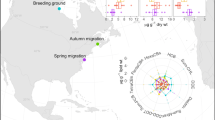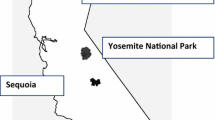Abstract
A large number of hazardous waste sites in the United States have undergone the initial stages of remediation or containment. At many of the remaining sites, the potential for exposure to ecological receptors is a primary concern. This manuscript reports on studies to investigate the impact on ecological receptors exposed to complex mixtures at a former creosote facility. Currently there are isolated areas on-site that were not addressed in the initial removal action that appear to be releasing polycyclic aromatic hydrocarbons (PAHs) to the surrounding environment. The U.S. EPA collected environmental samples and performed ex situ sediment bioassays to measure chronic toxicity; whereas, this study describes an in situ study to measure biomarkers of effect in two ecological receptors. Mosquitofish (Gambusia affinis) and cricket frogs (Acris crepitans) were collected from a small intermittent creek adjacent to the site, and reference stations. A weight-of-evidence ecological risk assessment was completed for the amphibian and fish communities. The ecological risk assessment was developed using analysis of media chemistry, body burden of specific PAHs, bioassay results, community surveys, and cellular genome size variation as a biomarker of genotoxicity. Flow cytometric estimates of chromosomal damage were significantly elevated for both mosquitofish and cricket frogs inhabiting the contaminated site, relative to at least one reference site. Surface water screening values for fish and amphibians exceeded screening values for PAHs by more than one order of magnitude in the on-site creek, and sediment PAH concentrations were extremely high (up to 1,549 μg/dry g). Tissue concentrations of PAHs were below screening values. Media chemistry, bioassay and genotoxicity data all support the same conclusion that on-site PAHs continue to impact aquatic receptors. The genotoxicity findings are consistent with and contribute to results of the weight-of-evidence ecological risk assessment. The results support continuing efforts to incorporate biomarkers as valuable lines of evidence within ecological risk assessment.





Similar content being viewed by others
References
ATSDR (2004) ToxFaQs™ for wood creosote, coal tar creosote, coal tar, coal tar pitch, and coal tar pitch volatiles. Agency for Toxic Substances and Disease Registry
Barbee GC, Barich J, Duncan B, Bickham JW, Matson CW, Hintze CJ, Autenrieth RL, Zhou G-D, McDonald TJ, Cizmas L, Norton D, Donnelly KC (2008) In situ biomonitoring of PAH-contaminated sediments using juvenile coho salmon (Oncorhynchus kisutch). Ecotoxicol Environ Saf 71:454–464
Bickham JW, Hanks BG, Smolen MJ, Lamb T, Gibbons JW (1988) Flow cytometric analysis of the effects of low-level radiation exposure on natural populations of slider turtles (Pseudemys scripta). Arch Environ Contam Toxicol 17:837–841
Bickham JW, Sawin VL, Burton DW, McBee K (1992) Flow-cytometric analysis of the effects of triethylenemelamine on somatic and testicular tissues of the rat. Cytometry 13:368–373
Bickham JW, Sawin VL, McBee K, Smolen MJ, Derr JN (1994) Further flow cytometric studies of the effects of triethylenemelamine on somatic and testicular tissues of the rat. Cytometry 15:222–229
Bickham JW, Mazet JA, Blake J, Smolen MJ, Lou Y, Ballachey BE (1998a) Flow-cytometric determination of genotoxic effects of exposure to petroleum in mink and sea otters. Ecotoxicology 7:191–199
Bickham JW, Rowe GT, Palatnikov G, Mekhtiev A, Mekhtiev M, Kasimov RY, Hauschultz DW, Wickliffe JK, Rogers WJ (1998b) Acute and genotoxic effects of Baku Harbor sediment on Russian sturgeon, Acipenser guildensteidti. Bull Environ Contam Toxicol 61:512–518
Bickham JW, Sandhu S, Hebert PD, Chikhi L, Athwal R (2000) Effects of chemical contaminants on genetic diversity in natural populations: implications for biomonitoring and ecotoxicology. Mutat Res 463:33–51
Bihari N, Fafandel M (2004) Interspecies differences in DNA single strand breaks caused by benzo(a)pyrene and marine environment. Mutat Res 552:209–217
CH2MHill (2005) Remedial investigation and feasibility study report. Jasper Creosoting Company, Jasper
Custer TW, Custer CM, Hines RK, Sparks DW, Melancon MJ, Hoffman DJ, Bickham JW, Wickliffe JK (2000) Mixed-function oxygenases, oxidative stress, and chromosomal damage measured in lesser scaup wintering on the Indiana Harbor Canal. Arch Environ Contam Toxicol 38:522–529
De Flora S, Bennicelli C, Bagnasco M (1994) Genotoxicity of mercury compounds. A review. Mutat Res 317:57–79
Depledge MH (1994) Genotypic toxicity: implications for individuals and populations. Environ Health Perspect 102(Suppl 12):101–104
Eisler R (1987) Polycyclic aromatic hydrocarbon hazards to fish, wildlife, and invertebrates: a synoptic review. 1.11. U.S. Fish and Wildlife Service, USA
Folt CL, Chen CY, Moore MV, Burnaford J (1999) Synergism and antagonism among multiple stressors. Limnol Oceanogr 44:864–877
Gagne F, Trottier S, Blaise C, Sproull J, Ernst B (1995) Genotoxicity of sediment extracts obtained in the vicinity of a creosote-treated wharf to rainbow trout hepatocytes. Toxicol Lett 78:175–182
Gauthier L, Tardy E, Mouchet F, Marty J (2004) Biomonitoring of the genotoxic potential (micronucleus assay) and detoxifying activity (EROD induction) in the River Dadou (France), using the amphibian Xenopus laevis. Sci Total Environ 323:47–61
George LS, Dallas CE, Brisbin IL Jr, Evans DL (1991) Flow cytometric DNA analysis of ducks accumulating 137Cs on a reactor reservoir. Ecotoxicol Environ Saf 21:337–347
Incardona JP, Collier TK, Scholz NL (2004) Defects in cardiac function precede morphological abnormalities in fish embryos exposed to polycyclic aromatic hydrocarbons. Toxicol Appl Pharmacol 196:191–205
La Point TW, Waller WT (2000) Field assessments in conjunction with whole effluent toxicity testing. Environ Toxicol Chem 19:14–24
Lamb T, Bickham JW, Gibbons JW, Smolen MJ, McDowell S (1991) Genetic damage in a population of slider turtles (Trachemys scripta) inhabiting a radioactive reservoir. Arch Environ Contam Toxicol 20:138–142
Landis WG, Yu M-H (1995) Introduction to environmental toxicology: impacts of chemicals upon ecological systems. Lewis Publishers, Boca Raton
Malins DC, McCain BB, Landahl JT, Myers MS, Krahn MM, Brown DW, Chan S-L, Roubal WT (1988) Neoplastic and other diseases in fish in relation to toxic chemicals: an overview. Aquat Toxicol 11:43–67
Maria VL, Correia AC, Santos MA (2003) Genotoxic and hepatic biotransformation responses induced by the overflow of pulp mill and secondary-treated effluents on Anguilla anguilla L. Ecotoxicol Environ Saf 55:126–137
Maria VL, Correia AC, Santos MA (2004) Genotoxic and biochemical responses in caged eel (Anguilla anguilla L.) after short-term exposure to harbour waters. Environ Int 29:923–929
Matson CW, Franson JC, Hollmen T, Kilpi M, Hario M, Flint PL, Bickham JW (2004) Evidence of chromosomal damage in common eiders (Somateria mollissima) from the Baltic Sea. Mar Pollut Bull 49:1066–1071
Matson CW, Palatnikov G, Islamzadeh A, McDonald TJ, Autenrieth RL, Donnelly KC, Bickham JW (2005a) Chromosomal damage in two species of aquatic turtles (Emys orbicularis and Mauremys caspica) inhabiting contaminated sites in Azerbaijan. Ecotoxicology 14:513–525
Matson CW, Palatnikov GM, McDonald TJ, Autenrieth RL, Donnelly KC, Anderson TA, Canas JE, Islamzadeh A, Bickham JW (2005b) Patterns of genotoxicity and contaminant exposure: evidence of genomic instability in the marsh frogs (Rana ridibunda) of Sumgayit, Azerbaijan. Environ Toxicol Chem 24:2055–2064
McBee K, Bickham JW (1988) Petrochemical-related DNA damage in wild rodents detected by flow cytometry. Bull Environ Contam Toxicol 40:343–349
Monson PD, Call DJ, Cox DA, Liber K, Ankley GT (1999) Photoinduced toxicity of fluoranthene to northern leopard frogs (Rana pipiens). Environ Toxicol Chem 18:308–312
Mueller JG, Middaugh DP, Lantz SE, Chapman PJ (1991) Biodegradation of creosote and pentachlorophenol in contaminated groundwater: chemical and biological assessment. Appl Environ Microbiol 57:1277–1285
Peterson JS, Bain LJ (2004) Differential gene expression in anthracene-exposed mummichogs (Fundulus heteroclitus). Aquat Toxicol 66:345–355
Preston BL, Shackelford J (2002) Multiple stressor effects on benthic biodiversity of Chesapeake Bay: implications for ecological risk assessment. Ecotoxicology 11:85–99
Preston BL, Snell TW, Fields DM, Weissburg MJ (2001) The effects of fluid motion on toxicant sensitivity of the rotifer Brachionus calyciflorus. Aquat Toxicol 52:117–131
Shugart LR, Theodorakis CW, Bickham AM, Bickham JW (2003) Genetic effects of contaminant exposure and potential impacts on animal populations. In: Hoffman DJ, Rattner BA, Burton GA Jr, Cairns J Jr (eds) Handbook of ecotoxicology, 2nd edn. Lewis Publishers, Boca Raton, pp 1129–1147
Theodorakis CW, Bickham JW, Lamb T, Medica PA, Lyne TB (2001) Integration of genotoxicity and population genetic analyses in kangaroo rats (Dipodomys merriami) exposed to radionuclide contamination at the Nevada Test Site, USA. Environ Toxicol Chem 20:317–326
Timme-Laragy AR, Cockman CJ, Matson CW, Di Giulio RT (2007) Synergistic induction of AHR regulated genes in developmental toxicity from co-exposure to two model PAHs in zebrafish. Aquat Toxicol 85:241–250
USEPA (1996a) Method 3510C: pressurized fluid extraction (PFE), SW-486, test methods for evaluating solid waste physical/chemical methods. United States Environmental Protection Agency, Washington, DC
USEPA (1996b) Method 3545: pressurized fluid extraction (PFE), SW-486, test methods for evaluating solid waste, physical/chemical methods. United States Environmental Protection Agency, Washington, DC
USEPA (1996c) Method 8270C: semivolatile organic compounds by gas chromatography/mass spectrometry (GC/MS), SW-846, test methods for evaluating solid waste, physical/chemical methods. United States Environmental Protection Agency, Washington, DC
USEPA (2004) Hart creosoting company fact sheet, vol 2005. United States Environmental Protection Agency, Washington, DC
USEPA (2005a) Pesticides: creosote and its use as a wood preservative. United States Environmental Protection Agency, Washington, DC
USEPA (2005b) U.S. EPA integrated risk information system (IRIS), vol 2005. U.S. Environmental Protection Agency, Washington, DC
Vindelov LL, Christensen IJ (1990) A review of techniques and results obtained in one laboratory by an integrated system of methods designed for routine clinical flow cytometric DNA analysis. Cytometry 11:753–770
Vindelov LL, Christensen IJ (1994) Detergent and proteolytic enzyme-based techniques for nuclear isolation and DNA content analysis. In: Darzynkiewicz Z, Robinson JP, Crissman HA (eds) Flow cytometry: methods in cell biology, 2nd edn, Part A. Academic, New York, pp 219–229
Wassenberg DM, Di Giulio RT (2004a) Synergistic embryotoxicity of polycyclic aromatic hydrocarbon aryl hydrocarbon receptor agonists with cytochrome P4501A inhibitors in Fundulus heteroclitus. Environ Health Perspect 112:1658–1664
Wassenberg DM, Di Giulio RT (2004b) Teratogenesis in Fundulus heteroclitus embryos exposed to a creosote-contaminated sediment extract and CYP1A inhibitors. Mar Environ Res 58:163–168
Winter MJ, Day N, Hayes RA, Taylor EW, Butler PJ, Chipman JK (2004) DNA strand breaks and adducts determined in feral and caged chub (Leuciscus cephalus) exposed to rivers exhibiting variable water quality around Birmingham, UK. Mutat Res 552:163–175
Wirgin I, Waldman JR (1998) Altered gene expression and genetic damage in North American fish populations. Mutat Res 399:193–219
Zucker RM, Elstein KH, Easterling RE, Massaro EJ (1990) Flow cytometric analysis of the mechanism of methylmercury cytotoxicity. Am J Pathol 137:1187–1198
Acknowledgments
The authors acknowledge the technical support and guidance of staff from the USEPA and Texas Parks and Wildlife Department. This work was funded by Texas A&M NIEHS Superfund Basic Research Program (P42ES04917). Partial salary support was provided to C.W.M. by the Duke NIEHS Superfund Basic Research Center (P42ES010356). An earlier version of this manuscript was included as a chapter in the dissertation of A.M.G.
Author information
Authors and Affiliations
Corresponding author
Additional information
K. C. Donnelly deceased.
Rights and permissions
About this article
Cite this article
Matson, C.W., Gillespie, A.M., McCarthy, C. et al. Wildlife toxicology: biomarkers of genotoxic exposures at a hazardous waste site. Ecotoxicology 18, 886–898 (2009). https://doi.org/10.1007/s10646-009-0350-1
Received:
Accepted:
Published:
Issue Date:
DOI: https://doi.org/10.1007/s10646-009-0350-1




